Green bonds have never been in such great demand before. KfW is a market leader in the eco-bond field. Otto Weyhausen-Brinkmann and his team coordinate these sustainable investments, and they are ready to ramp up their activities.
About Mr Weyhausen-Brinkmann
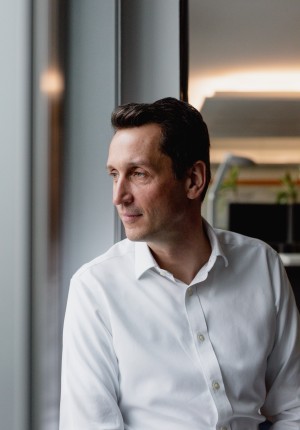
Otto Weyhausen-Brinkmann is the head of funding at KfW.
At KfW’s Head Office in Frankfurt, there is one place that is different from all the rest. Behind a security door at the end of a winding corridor on the fourth floor, Otto Weyhausen-Brinkmann’s empire begins.
Weyhausen-Brinkmann is the head of funding at KfW. Along with his five-person team, he is responsible for collecting the money that the promotional bank on-lends via its wide range of loan programmes. This is mainly accomplished by issuing bonds, and has proven to be quite a success. The bonds bring in around EUR 75 billion a year, which usually requires 150 issues. The bond buyers give KfW their capital over a set period. After the period is over, they receive it back – and in the meantime, they benefit from a pre-agreed interest rate, regardless of how KfW uses the money.
So far, so normal in the banking world. However, as climate change worsens, green bonds – bonds that involve money flowing exclusively into sustainable projects – have become an increasingly important part of funding work in the industry. They first became a part of the global economy close to 20 years ago. The first issuer was the City of San Francisco in 2001, which sought to use these bonds – still known at the time as “solar bonds” – as a means to finance measures to combat climate change. What began as a curiosity has now become a major factor in the market. KfW has been offering green bonds for six years, along with “normal” bonds. The money raised flows into the bank’s Renewable Energies – Standard and Energy-efficient Construction loan programmes. In 2019, KfW increased its green bond volume to a record EUR 8 billion. “We’re the largest provider on the German market,” says Otto Weyhausen-Brinkmann.
Read more under the image gallery.
Otto Weyhausen-Brinkmann in his office in Frankfurt.
On the face of it, it is hard to tell that the 43-year-old regularly handles billions of euros. “That’s a routine thing for me,” he explains. Weyhausen-Brinkmann looks at his team from his glass-walled office. Most of them sit in front of computer screens, which are placed in several rows in the large room. Many have phones to their ears, almost akin to a call centre. Weyhausen-Brinkmann has hung caricatures of himself and his colleagues on the wall of his office, which have appeared in the trade press over the years, usually on major issuing days. A number of them have come his way over the years – Weyhausen-Brinkmann has been with KfW for over a decade. And despite his position, he does not take himself too seriously. This cool demeanour enables him to remain calm even on issuing days.
Because that is when it counts. KfW announces the issuing the day before. The order books always open at nine o’clock, and the institutional investors indicate how many of the bonds they want to buy from KfW. “Normally, we know who wants to invest and how much they want to invest in advance,” Weyhausen-Brinkmann explains. “Preparation is everything.” As a result, the only adrenaline rush left on issuing day comes from whether expectations are met. Usually, this is not a problem. After a few hours, the expected volume is reached, the order books are closed and another bond has been issued.
Eco-bonds are of particular demand in Scandinavia and Benelux
KfW is in a particularly comfortable position when it comes to green bonds. The interest in green bonds is so enthusiastic that, as an issuer, KfW even has to slow things down in some cases. Sustainable investment plays an especially large role in Scandinavia and the Benelux countries, Weyhausen-Brinkmann states. “But we can only collect money that will eventually be extended as a loan.” And there are only a limited number of projects able to qualify for the two sustainable loan programmes, he adds. Simply hoarding money away in its accounts is not part of KfW’s business model.

Otto Weyhausen-Brinkmann talking to Henrik Pontzen from Union Investment.
Not being permitted to retain too much money is one side of the coin. The other is that the bonds issued are also in demand – ideally even oversubscribed. “If we make a bond for 100 million available and are only able to sell 50 million, that’s bad for our image to begin with,” Weyhausen-Brinkmann explains. This means the preparations he and his team make before issuing day are all the more important. The financing experts stay in constant touch with the business partners. Who is cash-rich right now? Who is looking specifically for sustainable investment opportunities? “If we feel there’s no market demand for a KfW bond at a given moment, then we won’t go ahead with one,” he says. But if it seems like a good time, it then becomes a matter of setting the price. The crucial factor here is demand. If Weyhausen-Brinkmann and his team can venture to suppose that the investors will battle for the shares, they set a higher price accordingly.
In principle, anyone can invest in KfW’s bonds. “But with green bonds, we take a while to examine who’s looking to buy,” he explains. Investors who invest sustainably out of a sense of conviction are given preference over hedge funds that only see the bond as a form of speculation.
Big players rely on KfW
Other factors then play a role in deciding on the issuing day. The interest rate swap price plays a decisive role in this process. In simple terms, this shows the current level of demand for fixed interest rates versus variable interest rates. KfW selects the most opportune time to bring its fixed-interest bonds to market. The current interest rate situation on the market plays strongly into KfW’s hands when it sets its own interest rates. “Hardly anyone pays lower interest rates than us when we raise money from the capital market,” Weyhausen-Brinkmann says. As a state-owned bank, KfW is regarded as highly reliable, and the money invested there is consequently seen as very safe. In particular, large institutional investors – often central banks, asset managers or insurance companies – are currently desperately looking for risk-free ways to invest their money. KfW benefits from this. “Needless to say, the KfW bond won’t be much of a draw for private investors,” the financing expert says, “but for the major players in the financial market, it’s a good way to keep money safe.” And if they buy green bonds, they can even do so with a clear environmental conscience.
One of these major players is Union Investment, a subsidiary of DZ Bank. Henrik Pontzen is the head of the ESG department, which pursues sustainable action in the environmental, social and governance spaces as part of Union Investment’s portfolio management function. He has noticed that more and more customers are pushing for their money to be invested not just with a focus on returns, but also with sustainability in mind. “Green bonds are an important tool for us in that context,” he says. When examining their green investments, Pontzen and the 60 or so sustainability analysts at Union Investment deliberately look at more than simply which projects are due to receive the money. “For us, it’s also important who the issuer is,” he explains. Through that lens, a tank manufacturer that finances sustainable projects on its factory grounds would be fairly difficult to justify. “But with the profile it has, KfW complements us very well. We can depend on their internal audits and reporting.”
As a market leader in green bonds, the bank has also committed itself to proving that green investments are truly green. “We compile extensive reports year after year to look into that question,” Weyhausen-Brinkmann notes. In these documents, the bank’s loan department shows which projects have received the money from the green bonds. Among these are Germany’s first energy self-sufficient multi-family house, which was completed in the town of Wilhelmshaven, as well as large-scale wind and solar farms. For instance, in 2017, the bank gave almost 20 million euros to a wind farm in Dretzen in the state of Brandenburg – over 80 percent of the total cost. “As a matter of principle, we promote activities right across the board in the field of energy-efficient construction: the construction of new homes, multi-family housing, student residences and multi-storey buildings,” explains Ralf Preußner, KfW product manager for the programme. The bank provides up to 120,000 euros per residential unit for new buildings, with a low annual interest rate. “In addition, depending on the construction project, there may also be a repayment bonus,” Preußner adds. This means that borrowers end up having to pay back less than they originally borrowed. Anyone can apply, whether they are large building owners, private individuals or cooperative societies.
“Green bonds alone will not stop climate change,” Otto Weyhausen-Brinkmann says, looking down on Frankfurt out of his window. But they certainly have a role to play, he believes. If he could, he would make even more of them available. “If the demand for credit increases significantly, we’ll definitely be ready at our end.”
Addendum
In the period from 1 June 2022 to 31 May 2024, Otto Weyhausen-Brinkmann will be head of the "Strategy Abroad" team in KfW's Group Development Department for two years as part of an internal job rotation.
Published on KfW Stories: 1 September 2020, updated on 1 June 2022.

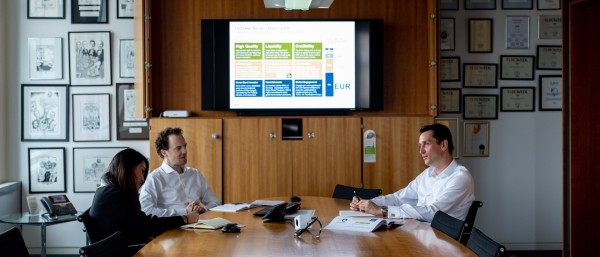
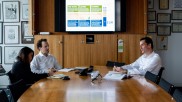

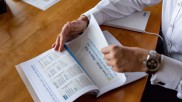

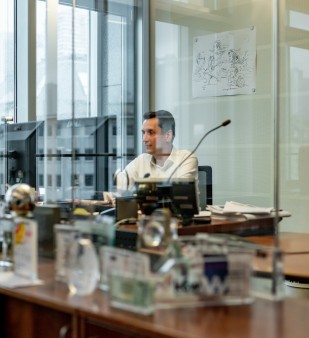

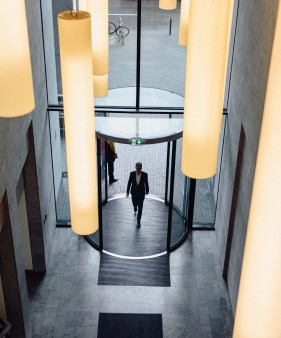
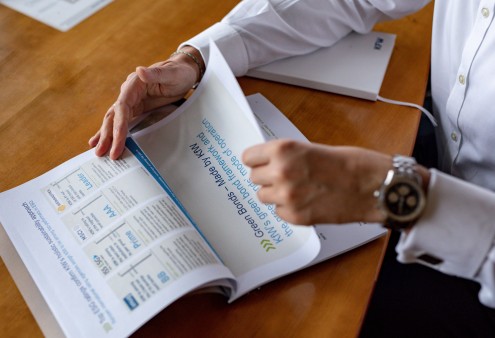




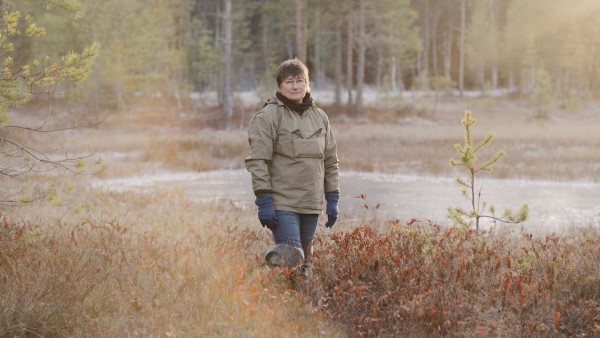
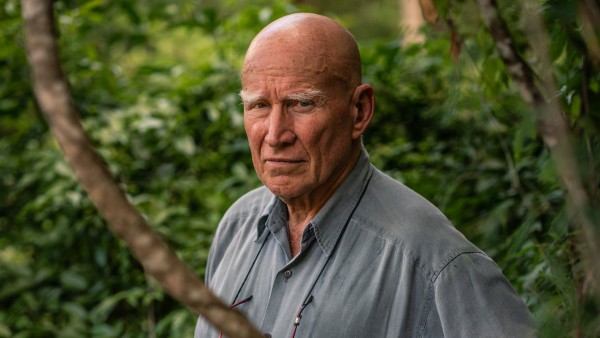
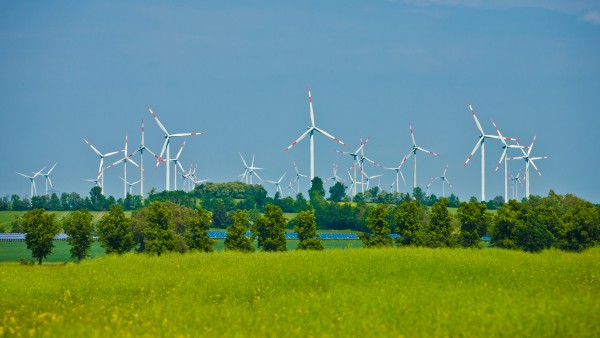
Data protection principles
If you click on one of the following icons, your data will be sent to the corresponding social network.
Privacy information